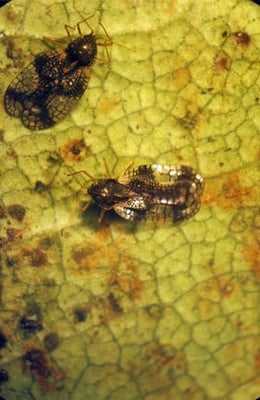
Quick facts
Common names - Pieris lacebug, andromeda lacebug
Scientific name - Stephanitis takeyai
Plants affected - Pieris and rhododendron
Main symptoms - Pale and mottled upper leaf; lower leaf surface has brown excrement with flattened insects and cast skins
Caused by - A sap-sucking insect
Timing - May-October
What is pieris lacebug?
Lacebugs are sucking true bugs in the family Tingidae. About 20 species occur in Britain. They are named after the lace like appearance of the wings. Find out more about British species from .
Pieris lacebug is a small (3-4 mm long) insect, its wings are marked with a black and white lace-like pattern. It can be responsible for causing pale mottling most notably on the leaves of Pieris and Rhododendron. Rhododendron can also be host to the Rhododendron lacebug Stephanitisrhododendri, however, since its arrival in Britain pieris lacebug has become the most frequently found.
Symptoms
Look out for the following symptoms of pieris lacebug on Pieris and Rhododendron:
- The foliage develops a coarse pale mottling on the upper surface and by late summer the leaves can have a bleached whitish yellow appearance
- Heavy feeding damage may cause leaf drop on Pieris
- The underside of affected leaves is discoloured with brown excrement spots
- Adults, nymphs and cast skins may be seen on the lower leaf surface
- The adults are black insects, 3 mm long, with wings that are held flat over the insect’s body. The wings are transparent with a broad black X-shaped marking
- The nymphs are wingless and have spiny blackish brown bodies
Note that rhododendrons can also be damaged by the rhododendron lacebug, Stephanitis rhododendri. This causes similar damage but is much less common than pieris lacebug and is not found on Pieris. Rhododendron lacebug has wings that are only faintly marked with a darker line across the wings near the base.
Management
- Where possible tolerate populations of pieris lacebug
- Encourage predators and other natural enemies of suckers, in the garden, such as birds , ladybirds , wasps and ground beetles
Biology
Pieris lacebug overwinters as eggs that are inserted into the leaf veins but adult insects can persist on the foliage until mid-winter.
The eggs hatch in May and the nymphs initially cluster together on the underside of leaves. They later disperse and reach the adult stage by mid to late summer.
Rhododendron lacebug has a similar lifecycle.
